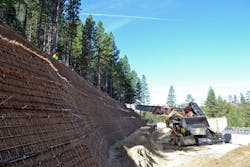Geogrids, custom wire form facing and rock anchor system for Lake Tahoe, Nev., project
The scenic U.S. 50 twists and turns its way past Lake Tahoe, Nev. It cuts through mountains, forests and desert valley with steep grades and hairpin turns. Rocky outcrops bound the highway, and a stretch of road between Cave Rock Tunnel and the junction of U.S. 50 and S.R. 28 was in need of repair. Three slopes—a combined total of 80,000 sq ft and reaching vertical heights of 90 ft—had started failing, and falling debris was creating safety hazards for drivers. Excessive runoff with sediments was also a concern, due to the possibility of it flowing into Lake Tahoe and causing ecological damage. Adding to the list of challenges in this mountainous terrain were strict guidelines set by the Tahoe Regional Planning Agency (TRPA). These guidelines required the proposed solution to integrate seamlessly into the natural landscape. The last and most important challenge was the geologic makeup of the slopes—rock lay just below the failing surface, making anchoring and soil reinforcement difficult.
The solution
The Nevada Department of Transportation (DOT) consultants designed a sole-source proprietary steel reinforced slope system. Due to the high costs, the successful low-bid contractor immediately started looking for a more economical way of reconstructing the slopes. Strata Systems was contacted and quickly developed a plan that called for utilizing StrataSlope with Stratagrid attached to drilled rock anchors to hold the facing to the rock slope. Strata consulted with Terracon Consulting Engineers Inc. about the concept and developed a preliminary design and proposal. The solution provided significant cost savings and construction benefits to the contractor. Strata Systems gave value-engineering presentations to the Nevada DOT, its consultant and TRPA before finally gaining approval for this unique concept. Strata’s solution was chosen for its cost savings, ease of installation, strength, stability and ability to blend into the natural surroundings. The approved plan would incorporate SG150, SG350, SG600, a custom-welded wire-form basket facing and a rock anchor system. Before final designs could take place, Strata conducted laboratory testing to determine the connection capacity between the Stratagrid and the rock-anchoring system.
The anchoring system was pivotal in the success of the project, and it was specifically designed to utilize the underlying rock for support. Terracon was hired to design the rock-anchor system, including analyzing the anchor spacing and pullout resistance needed to support the StrataSlope facing system. A 7-ft piece of 3-in.-diameter pipe was bolted to each anchor point. SG600 was then attached to the pipe with a wrap connection and extended to the wire forms, providing a stable connection between the slope face and basket.
TRPA required a natural-looking slope facing that did not utilize shiny metal. To adhere to these visual standards, Strata created custom, non-galvanized baskets with a 60-degree batter. Coconut blanket was hydro-seeded with indigenous seeds and then placed in the face of the basket along with SG150 to provide facing reinforcement. The area surrounding Lake Tahoe is a semi-arid environment, so the contractor is required to irrigate the slope facings on a regular basis for three years to ensure the establishment of native vegetation.
The result
The geogrid-reinforced slopes meet all NDOT and TRPA requirements. Not only has this geogrid solution reduced soil erosion, stabilized the slope and increased traffic safety, but it also reduced material costs by $80,000 compared to previous proposals received by NDOT.
